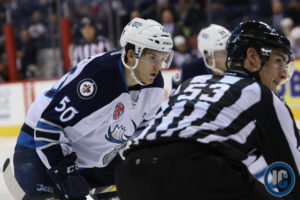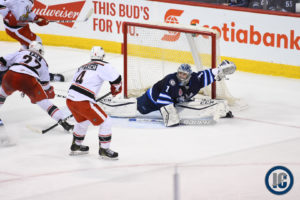The Manitoba Moose have several prospects who may join the big club one day, but there are three in particular who merit special attention.

Not only do these three have NHL potential, they may even become impact players one day for the Winnipeg Jets. Let’s take a look at their play this season, their skill-set, and an estimated time of arrival for each of them.
LW Kyle Connor
6’1, 180 | DOB – 12/9/1996 | AHL – 52 GP – 25G – 19A – 44P | NHL – 20 GP | 2G | 3A | 5P

If there was any doubt that he was a blue-chip NHL prospect, Connor has put those fears has to rest. The teenager who started the season meekly with the Winnipeg Jets grew by leaps and bounds in the final months of the AHL season. Most Jets fans were probably disappointed with Connor’s NHL debut, as he struggled to produce (4 points in 19 GP) while playing bottom-6 minutes with the Jets. He became a frequent healthy scratch for the Jets, and was finally assigned to the Moose in early December.
He started slowly with the Moose, scoring just 8 goals in the first 32 games, and while he showed obvious skill all along, he failed to dominate for large stretches. Then came the month of February, and suddenly Connor began imposing his will on almost every game. There was one particular game outing may have been the turning point: the Moose squared off against the Rockford Ice Hogs on February 22 at MTS Centre. Despite being held scoreless, Connor utterly dominated with 8 shots on goal – quality chances that he generated himself. It was only by chance that he was held off the board that night, and the very next game, the dam burst, as he lit the lamp three times. Connor ended the season with a staggering 17 goals in the final 20 games, including a six-game streak where he lit the lamp 10 times. He even played significant chunks of those games with Patrice Cormier and J.C Lipon – good veterans, but adept playmakers, they are not.
His 2017 coup de gras was a strong performance in the Jets’ season finale, where he tied the game late in the third period with some nice finish. It’s also worth noting that Connor virtually owned the podium at the team’s end-of-season awards, winning Rookie of the Year, the 3-stars award, and team MVP.
In terms of his package of skills, Connor is nearly unparalleled in the American Hockey League. He’s simply too fast, and too dynamic for defenders to handle:
…the release on his shot, too quick for goaltenders to stop:
…and his playmaking, not far behind his other skills:
But the thing about Connor’s offensive game that doesn’t stand out enough in those clips is his all-out ability to control play. His combination of skill, speed and hockey sense are so high that he can consistently take over a shift and play exclusively in the offensive zone. Furthermore, his ability to hunt the slot is incredible – in the past two years of watching Moose games, I’m not sure there’s been an AHL’er who is more effective at getting the puck into dangerous scoring areas.
In terms of areas of improvement, being “hard on the puck” is an obvious area, but probably not one to be concerned about – it’s something he will improve as he gains more core/leg strength. His overall defensive play is well behind the rest of his game, although he does show good will on the backcheck. At times he seems disinterested in the play when he doesn’t have the puck, and while that does need to change, future NHL coaches may have to accept that this may never be a strength of his game.
ETA: Given his progression this season, and his position (LW), it would be pretty surprising if Connor didn’t make the Jets next season. Given the lack of offensive punch in the bottom-6, (Shawn Matthias is more suited to a fourth line role), Connor would be a welcome addition on the third line. He’s probably ready to play at least 12 minutes per game at even-strength, along with a bit of powerplay time.
Audio:
Audio PlayerKyle Connor’s end of season interview.
Moose Head Coach, Pascal Vincent On Connor’s skill-set:
“Kyle Connor has a lot of skills…he’s got speed, he’s got hands…he’s got offensive hockey sense that is way above average…what he does the best is self-evaluation after a game”
C Jack Roslovic
6′, 180 | DOB – 1/29/1997 | AHL – 65 GP – 13G – 35A – 48P

Photo Credit: Rodney Braun
To say that Jack Roslovic had a whirlwind year is probably an understatement – he started with the Jets’ summer development camp in July, then went to rookie camp in September and NHL training camp shortly thereafter; though he could have played in the OHL this season with the powerhouse London Knights, he (along with the organization) elected to start his pro career, and he made his AHL debut in mid-October. Still eligible to play in the World Junior Championships, he joined the US at Christmas and won gold; shortly after his return in January, he was named an AHL All-Star; to cap it all off, in April, he made his NHL debut in his home state of Ohio. In all, he played 73 games (excluding the rookie tournament and exhibition play), but that was a big step up considering he played just 36 the prior year in the NCAA.
Along the way, all he did was impress. Those who followed the Penticton rookie tournament called him the second best player in the tournament (after Oilers’ 2016 4th overall pick, Jesse Puljujarvi). Despite being a highly offensive player, he played an effective shut-down role for the US at the World Juniors. He led the Moose in scoring almost wire-to-wire – an impressive feat given that most teenagers don’t even play in the league, never mind excel in it. He also became a fixture on the Moose pk, getting valuable experience to help round out his two-way game.
As far as his skill-set goes, he’s not quite as high-end as Kyle Connor, but he might be even more well-rounded. He’s a great skater who easily gets separation from defenders at the AHL level; he has great puck control, and he can pass equally well off of forehand and backhand. He shows off a few of those attributes here:
Wondering about his shot? it’s not bad either:
…and in case you haven’t seen his speed, take a peak at this:
For those who haven’t seen much of Roslovic, here’s a comparison in terms of style: Bruins centre David Krejci. They’re both 6′ and somewhat slight of build; they’re both right-handed centres; they’re both excellent playmakers who are very cerebral in their approach; each of them like to control the puck in the offensive zone, particularly on the powerplay; each has a good shot, but prefers to pass; and each of them plays a strong defensive game. Roslovic may not have as much offensive upside as Krejci, but he’s probably a better skater.
ETA: Given that Roslovic is a ’97 birth year (Connor is a ’96), and plays centre, it’s more likely that he starts next season with the Moose. The Jets have some depth down the middle with Scheifele, Little, Lowry, Copp, and Petan, and there’s no harm in him playing another half-season or so in the minors. It’s worth noting that Roslovic did play primarily on RW during his younger years, so there is the potential for him to slide over there at some point too. Regardless, unless he suffers a injury in the next 18 months, it’s pretty likely that he’ll be a full-time Jet by the fall of 2019, if not earlier.
Audio:
Audio PlayerJack Roslovic end of season interview.
Moose Head Coach, Pascal Vincent on Roslovic’s potential to make the Jets next season:
“…the sky’s the limit, with the potential that he has, who knows what’s gonna happen…I think he’s got a big summer ahead of him and I think he will use it properly”
Eric Comrie
6’1, 180 | DOB – 7/6/1995 | AHL – 51 GP – 16W – 26L – 2T – 3SO – 2.96 GAA – .906 Sv%

Photo Credit: Colby Spence
Eric Comrie has quietly become one of the most exciting prospects for the Winnipeg Jets, and one of the top goaltending prospects outside of the NHL. With 102 AHL games under his belt, he’s among the most experienced 21-year-old goaltenders you’ll ever see. (Interestingly, Comrie is keenly aware, as he often makes note of this fact in interviews). A second round pick in 2013, Comrie made 51 appearances this season for the Moose, and also picked up his first career win in his NHL debut. Comrie also took home the team’s humanitarian of the year award – a nod to his charitable work that focuses on schools and reading. News also came this week that Comrie will continue his on-ice development this spring, as he joins team Canada at the IIHF World Championships; he will be the youngest goaltender to represent Canada at this event since Jamie Storr in 1994.
In terms of his season with the Moose, those who take a brief look at the numbers may be skeptical of his talent, however, it’s very important to put them in context. The Moose struggled mightily in the defensive zone this season – the back-end was a fairly slow-footed group which had trouble exiting the zone, cutting off passing lanes, and marking dangerous attackers out front. These problems were exacerbated on the penalty kill, which finished 29th in the league at 77.2%. Traditionally, those who evaluate goalie statistics focus more on even-strength save percentage, as they feel that measure is more within a goaltender’s control as compared to performance while short-handed. (Those numbers aren’t readily available, but one can infer that Comrie’s .906 save% would be significantly better at even-strength given how bad the Moose were on the PK).
Despite the unflattering statistics, the broad consensus among those who have watched Comrie play regularly is that he possesses almost all the traits of a future NHL starting goalie. In fact, former NHL goaltender and current NHL analyst, Steve Valiquette, called Comrie one of the best goalie prospects he’s seen in the last 5 years. That’s particularly high praise coming from Valiquette, who is one of the most respected and knowledgeable public figures when it comes to goaltenders. So what’s all the fuss about? Well, name an attribute you’d like in a goaltender, and chances are it’s in Comrie’s toolbox – he’s very athletic, with great flexibility and lightning quick reflexes; he’s consistently well-positioned and square to shooters, and has very good rebound control for a young goalie; he also has great hockey sense and anticipation, which combined with his quickness, allows him to commit grand larceny on a fairly regular basis. His work ethic, attitude, and off-ice intelligence are absolutely first class, and he has the maturity of a seasoned veteran. If you’re looking to poke holes, perhaps the one thing that doesn’t stand out is his size – at 6’1, he isn’t small, but he gives up a few inches to many of the goalies that have entered the league in recent years.
ETA: Comrie turns 22 this summer, and while that may seem like an NHL-ready age for most high-end prospects, for a goaltender, he’s practically a child. The last early-20’s goalie to play near-starter minutes in the NHL was Carey Price, back in 2007-2009. However, it should be noted that the Carey Price we see today is nothing like the Carey Price of 10 years ago – back then, he was battling for playing time with Jaroslav Halak, and was in fact supplanted by Halak in 2010 when Price was almost 23. (That was the year that Halak engineered ridiculous playoff upsets over powerhouse Washington, followed by powerhouse Pittsburgh). Price’s save percentage in his first 6 years in the league were as follows:
– Age 20 – .920
– Age 21 – .905
– Age 22 – .912
– Age 23 – .923
– Age 24 – .916
– Age 25 – .905
This ties in with another insight that Steve Valiquette gave us recently – he believes that all goaltenders should play a minimum of 150 AHL games prior to playing in the NHL. If we look at Price first six seasons within the context of league-average save percentage (roughly .915), two would be considered above average, one about average, and three, below average. Price only played 12 AHL regular season games, along with 22 playoff games (he was actually Calder Cup MVP at 19), but according to Valiquette, even the game’s most dominant goaltender of the past five years could have used more minor-league seasoning, as the AHL provides a tremendous opportunity to play far more games under far less pressure.
To sum up – not only is there no harm in having Comrie play another full season in the AHL, there likely is far more benefit to him playing 50-60 games in the AHL as opposed to 15-25 games in the NHL. Depending on how Comrie fares this coming year, and how things pan out in Winnipeg, he may be the full-time back-up in Winnipeg as soon as the 2018-2019 season. (For those who are wondering, waiver eligibility will become a consideration after Comrie has either played 60 NHL games, or 4 seasons of pro hockey.)
Audio:
Audio PlayerEric Comrie end of season interview.
Moose Head Coach, Pascal Vincent on if Comrie’s numbers are a fair representation of his talent:
“…we were giving up a lot of shots against, some nights, and he responded well…he gave us a lot of wins this year, and the way he prepares himself, and the way he plays, and the way he practices – we just see the big picture…and this kid is a good goaltender…I don’t think his numbers [are] a good reflection of how good he is.”
Other Prospects
The Jets do have a nice collection of secondary prospects who played at least part of their season with the Moose, including Brendan Lemieux, Michael Spacek, Jansen Harkins, Nelson Nogier, Chase De Leo, Luke Green, and Jamie Phillips. No slight to those players, but they don’t have the upside of Connor, Roslovic, or Comrie, and in most cases, they’re further from being NHL-ready.



